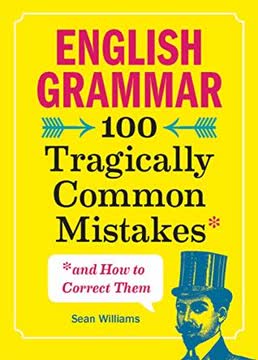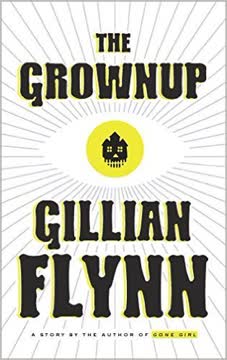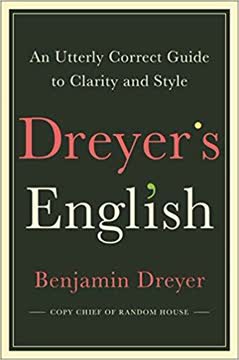Key Takeaways
1. Build Sentences on Solid Foundations
Every complete sentence needs a subject—the person, place, thing, or idea that is doing or being something—and a predicate (which finishes an idea about the subject).
Sentence completeness matters. An incomplete sentence leaves the reader guessing, presenting only a fragment of a thought. Ensuring each sentence has a subject performing or being something (the predicate) is the fundamental building block for clear communication.
Master core verbs. Irregular verbs like "go," "have," "be," and "do" are essential but often misused in various tenses. Understanding their correct forms (e.g., go/went/gone, do/did/done) and how they function as helping verbs is crucial for accurate expression.
Phrasal verb precision. Common multi-word verbs (like "try out" or "look forward to") require careful handling, especially with pronouns or gerunds. Keep their parts together and use the correct verb form (e.g., "divide up the bagels," "looking forward to seeing you").
2. Navigate the Maze of Pronouns
If you can replace the word with “he” or “she,” the proper choice is who. If the replacement can be “her” or “him,” whom is the correct usage.
Subject vs. Object. Pronouns change form depending on whether they are the subject (doing the action) or the object (receiving the action) in a sentence. This is particularly tricky when multiple pronouns are involved (e.g., "to him and me," not "him and I").
Reflexive pronoun use. Words like "myself" should only be used when the pronoun refers back to the subject of the sentence ("I hurt myself"). They are not substitutes for subject or object pronouns ("The check was sent to my wife and me," not "myself").
Agreement and clarity. Indefinite pronouns like "each" are singular and require singular verbs ("Each student is entitled"). Relative pronouns ("that," "which," "who") connect clauses and must refer clearly to the noun they modify, with "who" reserved for people. Modern usage is increasingly accepting singular "they" for gender neutrality or unknown subjects.
3. Master the Art of Punctuation
Commas add rhythm and beauty, not to mention clarity, to one’s written ideas.
Commas guide flow. Proper comma usage separates clauses, items in a series, and non-essential information, preventing run-ons (comma splices) and aiding readability. Avoid placing commas between a subject and its verb.
Apostrophes show possession. Use apostrophes to indicate ownership ("the dog's bone," "James's mom") or contractions ("it's," "they're," "you're"). Crucially, never use apostrophes to make nouns plural ("seven cats," not "cat's").
Dashes, colons, semicolons. Em dashes (—) can replace parentheses or colons for emphasis or asides. En dashes (–) connect number ranges or related concepts. Semicolons (;) join two related independent clauses. Colons (:) introduce lists, explanations, or long quotations.
4. Choose the Right Word, Every Time
English has so many words that are separated by a single letter.
Homophone hazards. Words that sound alike but have different spellings and meanings (like to/too/two, weather/whether/wether) are frequent sources of error. Double-checking their specific definitions is key.
Confusing pairs. Other pairs, like affect/effect, than/then, less/fewer, loose/lose, lay/lie, and accept/except, are easily mixed up due to similar sounds or spellings. Understanding their distinct roles (verb vs. noun, comparison vs. sequence, countable vs. uncountable, etc.) is vital for precision.
Precision in vocabulary. Words like "unique" (meaning one of a kind, not very special) or "literally" (meaning actually, not figuratively) are often misused as intensifiers. Using them correctly maintains the integrity of their meaning.
5. Craft Clear and Elegant Sentences
Misplacing your modifier can result in unexpected and startling mistakes, such as the humorous line from Groucho Marx: “I shot an elephant in my pajamas.”
Modifiers need anchors. Misplaced modifiers attach to the wrong word, creating awkward or nonsensical phrases. Dangling modifiers have no word to attach to at all. Ensure modifiers are placed directly next to the noun or verb they describe.
Avoid run-on sentences. Joining two or more independent clauses without proper punctuation or conjunctions creates run-ons. Fix them by using a period, semicolon, or a comma followed by a coordinating conjunction.
Parallel structure for balance. When listing items or ideas, use consistent grammatical form (e.g., all nouns, all -ing verbs, all infinitive phrases). This creates balance and clarity, making the sentence easier to read and understand.
6. Avoid Common Usage Blunders
“Alot” is not a word in the English language, yet many people persist in writing a lot as “alot,” as if it were right and normal to do so.
Non-words and contractions. Phrases like "could of," "should of," and "would of" are incorrect transcriptions of contractions ("could've," "should've," "would've"). Similarly, "alot" is not a word; the correct form is always "a lot."
Redundant negatives. Double negatives (like "can't get no satisfaction") can be confusing or, in formal writing, incorrect. While sometimes used for emphasis, they often obscure meaning.
Specific word errors. Avoid using "irregardless" (use "regardless") and "ext." or "ect." for "etc." (from Latin "et cetera"). Pay attention to the correct past participles for verbs like "get" (gotten in American English).
7. Understand Nuances of Style and Tone
Jargon is both a form of insider-based shorthand and a way to avoid a more detailed explanation.
Clarity over complexity. Avoid clichés, jargon, and redundancies ("past history," "final ending") that make writing stale or inaccessible. Choose fresh, precise language instead.
Voice and emphasis. Active voice ("Scientists conducted experiments") is generally more direct and vigorous than passive voice ("Experiments were conducted by scientists"), though passive voice has its uses (e.g., when the actor is unknown or unimportant).
Comparisons and superlatives. Form comparatives and superlatives correctly by adding -er/-est or using "more"/"most," depending on the word's length or if it's irregular (better/best, worse
[ERROR: Incomplete response]
Last updated:
FAQ
What is "English Grammar: 100 Tragically Common Mistakes" by Sean Williams about?
- Comprehensive Grammar Guide: The book is a practical reference that addresses 100 of the most common mistakes in English grammar, punctuation, vocabulary, and style.
- Accessible and Engaging: Written in a friendly, humorous tone, it aims to make grammar approachable for everyone, from students to professionals.
- Structure and Organization: The book is divided into four main chapters: Grammar Goofs, Punctuation Saves Lives, Word to the Wise, and High Style, each focusing on different aspects of language use.
- Interactive Elements: It includes quizzes, memory tips, and cheat sheets to reinforce learning and encourage active engagement with the material.
Why should I read "English Grammar: 100 Tragically Common Mistakes" by Sean Williams?
- Improve Communication Skills: The book helps readers avoid embarrassing mistakes and communicate more clearly and confidently in both writing and speech.
- Quick Reference Tool: Its concise, numbered entries make it easy to look up specific issues or refresh your memory on tricky topics.
- Real-World Examples: Each mistake is illustrated with incorrect and correct examples, making the rules easy to understand and apply.
- Modern and Inclusive: The book addresses contemporary issues in language, such as gender-neutral pronouns and differences between American and British English.
What are the key takeaways from "English Grammar: 100 Tragically Common Mistakes"?
- Common Mistakes Identified: Readers will learn to recognize and correct frequent errors in grammar, punctuation, word choice, and style.
- Clear Rules and Tips: The book provides straightforward rules, memory aids, and fun facts to help remember correct usage.
- Practical Application: Emphasis is placed on real-life writing and speaking situations, making the advice immediately useful.
- Language Evolves: The author highlights how language changes over time and encourages flexibility and understanding of context.
How is "English Grammar: 100 Tragically Common Mistakes" by Sean Williams structured?
- Four Main Chapters: The book is organized into Grammar Goofs, Punctuation Saves Lives, Word to the Wise, and High Style, each focusing on a different aspect of English usage.
- Numbered Entries: Each mistake is presented as a separate, clearly numbered entry, making navigation simple.
- Supplementary Materials: Includes cheat sheets for parts of speech and punctuation, a glossary, and a list of concise substitutions for wordy phrases.
- Quizzes and Memory Tips: Many entries feature quizzes and mnemonic devices to reinforce learning.
What are some of the most common grammar mistakes covered in "English Grammar: 100 Tragically Common Mistakes"?
- Incomplete Sentences: Explains how to identify and fix sentence fragments by ensuring every sentence has a subject and predicate.
- Who vs. Whom: Clarifies the difference and provides a simple substitution trick (he/she = who, him/her = whom).
- Pronoun Confusion: Covers nominative, objective, and possessive pronouns, especially when two pronouns are used together.
- Double Negatives: Warns against using two negatives in a sentence, which can create confusion or unintended meanings.
How does "English Grammar: 100 Tragically Common Mistakes" by Sean Williams address punctuation errors?
- Comma Usage: Details rules for commas in lists, clauses, and after introductory phrases, and discusses the Oxford comma.
- Apostrophes: Explains correct use for possessives, contractions, and holidays, and warns against using apostrophes for plurals.
- Hyphens, Dashes, and Ellipses: Differentiates between hyphens, en dashes, em dashes, and ellipses, with clear usage guidelines.
- Run-On Sentences and Comma Splices: Provides solutions for fixing run-ons and improperly joined independent clauses.
What vocabulary and word choice issues are explained in "English Grammar: 100 Tragically Common Mistakes"?
- Homophones and Confusables: Covers commonly confused words like affect/effect, to/too/two, lay/lie, and less/fewer.
- Redundancies and Clichés: Advises against overused phrases and unnecessary repetition, offering concise alternatives.
- Jargon and Verbing: Discusses the pitfalls of jargon and the trend of turning nouns into verbs (and vice versa).
- Modern Usage: Addresses evolving language, such as singular "they" and distinctions between American and British English.
What style and advanced usage topics are included in "English Grammar: 100 Tragically Common Mistakes"?
- Order of Adjectives: Explains the conventional order for multiple adjectives before a noun.
- Parallel Structure: Stresses the importance of consistency in lists and series for clarity and elegance.
- Active vs. Passive Voice: Clarifies when to use each and the impact on tone and responsibility.
- Comparatives and Superlatives: Outlines correct formation and common errors with adjectives and adverbs.
How does "English Grammar: 100 Tragically Common Mistakes" by Sean Williams help with tricky pronoun and agreement issues?
- Indeterminate Pronoun Reference: Teaches how to avoid vague pronoun usage that confuses the reader about who or what is being referred to.
- Number Agreement: Emphasizes matching subjects and verbs in number, even in complex sentences with intervening phrases.
- Dual Possession and Double Genitive: Explains how to correctly show shared ownership and avoid awkward constructions.
What are the best quotes from "English Grammar: 100 Tragically Common Mistakes" by Sean Williams and what do they mean?
- "Leave your tragic mistakes behind and, with apologies to William Shakespeare, let slip the dogs of grammar!" – Encourages readers to embrace learning and correcting mistakes with enthusiasm.
- "Commas add rhythm and beauty, not to mention clarity, to one’s written ideas." – Highlights the importance of punctuation for both style and understanding.
- "Language evolves and speech affects the way people write, so some rules fade." – Reminds readers that language is not static and that context matters.
- "Alot isn’t a word. It’s not a lot to remember." – Uses humor to reinforce a common spelling mistake.
What resources and tools does "English Grammar: 100 Tragically Common Mistakes" by Sean Williams provide for further learning?
- Cheat Sheets: Includes quick-reference guides for parts of speech and punctuation.
- Glossary: Defines key grammar terms and concepts for easy lookup.
- Substitution List: Offers 50 concise alternatives to long-winded phrases to improve clarity and brevity.
- Recommended Resources: Suggests dictionaries, online writing labs, and other grammar books for deeper study.
Who is Sean Williams, the author of "English Grammar: 100 Tragically Common Mistakes," and what is her approach to teaching grammar?
- Experienced Educator: Sean Williams teaches ethnomusicology, cultural studies, and writing at The Evergreen State College.
- Engaging and Relatable: She uses humor, real-life examples, and a conversational tone to make grammar accessible and enjoyable.
- Inclusive and Modern: Williams addresses contemporary language issues, such as gender-neutral pronouns and evolving usage.
- Supportive Philosophy: Her goal is to empower all English speakers to write and speak with clarity and confidence, regardless of their background.
Review Summary
English Grammar: 100 Tragically Common Mistakes receives mostly positive reviews, with readers praising its clear explanations, helpful examples, and entertaining approach to grammar. Many find it a useful reference for improving writing skills. The book covers common grammatical errors, punctuation, and word usage. Some reviewers note that explanations can be confusing at times, and a few find certain topics too basic. Overall, readers appreciate the book's concise format and practical advice for enhancing their grammar knowledge.
Similar Books
Download PDF
Download EPUB
.epub digital book format is ideal for reading ebooks on phones, tablets, and e-readers.









